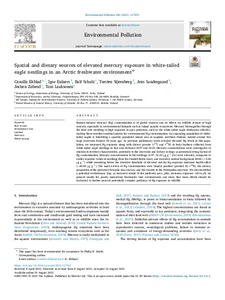Spatial and dietary sources of elevated mercury exposure in white-tailed eagle nestlings in an Arctic freshwater environment
Søndergaard Jens; Laaksonen Toni; Ekblad Camilla; Stjernberg Torsten; Zubrod Jochen; Schulz Ralf; Eulaers Igor
https://urn.fi/URN:NBN:fi-fe2021093048741
Tiivistelmä
Human-induced mercury (Hg) contamination is of global concern and its effects on wildlife remain of high concern, especially in environmental hotspots such as inland aquatic ecosystems. Mercury biomagnifies through the food web resulting in high exposure in apex predators, such as the white-tailed eagle (Haliaeetus albicilla), making them excellent sentinel species for environmental Hg contamination. An expanding population of white-tailed eagles is inhabiting a sparsely populated inland area in Lapland, northern Finland, mainly around two large reservoirs flooded 50 years ago. As previous preliminary work revealed elevated Hg levels in this population, we measured Hg exposure along with dietary proxies (δ13C and δ15N) in body feathers collected from white-tailed eagle nestlings in this area between 2007 and 2018. Mercury concentrations were investigated in relation to territory characteristics, proximity to the reservoirs and dietary ecology as potential driving factors of Hg contamination. Mercury concentrations in the nestlings (4.97–31.02 μg g−1 dw) were elevated, compared to earlier reported values in nestlings from the Finnish Baltic coast, and exceeded normal background levels (≤5.00 μg g−1) while remaining below the tentative threshold of elevated risk for Hg exposure mediated health effect (>40.00 μg g−1). The main drivers of Hg contamination were trophic position (proxied by δ15N), the dietary proportion of the predatory fish pike (Esox lucius), and the vicinity to the Porttipahta reservoir. We also identified a potential evolutionary trap, as increased intake of the preferred prey, pike, increases exposure. All in all, we present results for poorly understood freshwater lake environments and show that more efforts should be dedicated to further unravel potentially complex pathways of Hg exposure to wildlife.
Kokoelmat
- Rinnakkaistallenteet [19250]
